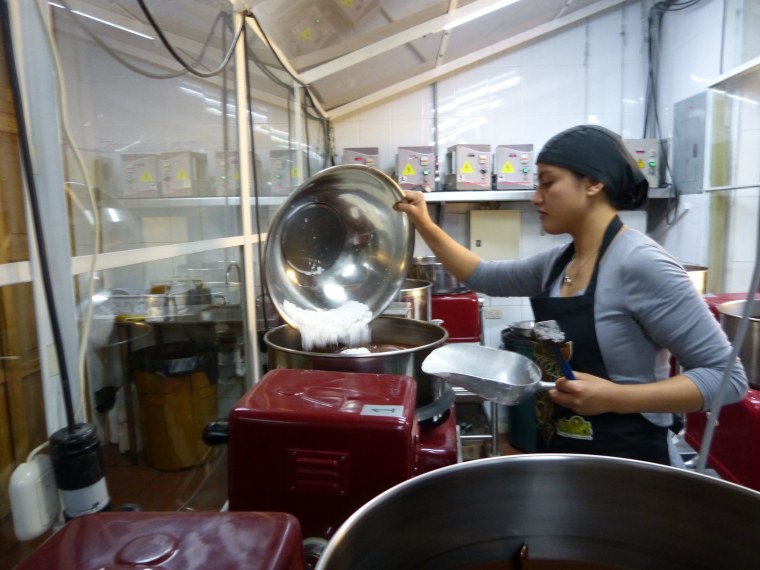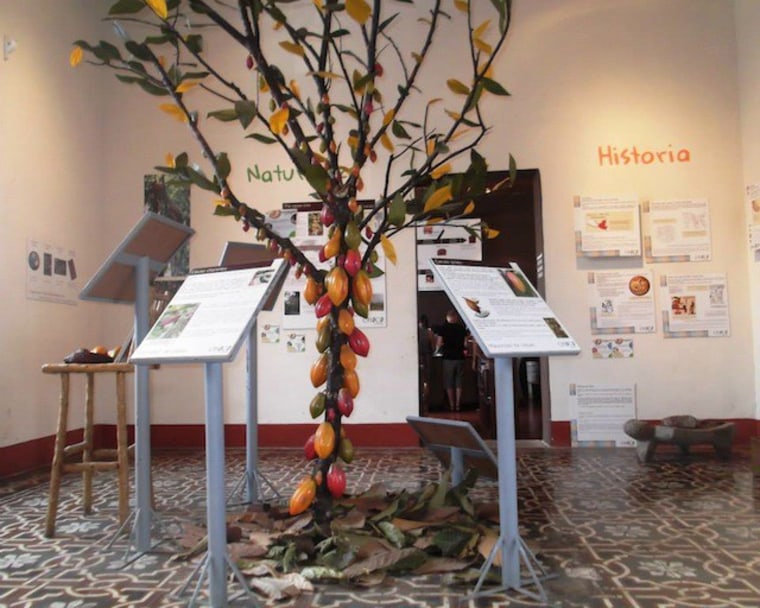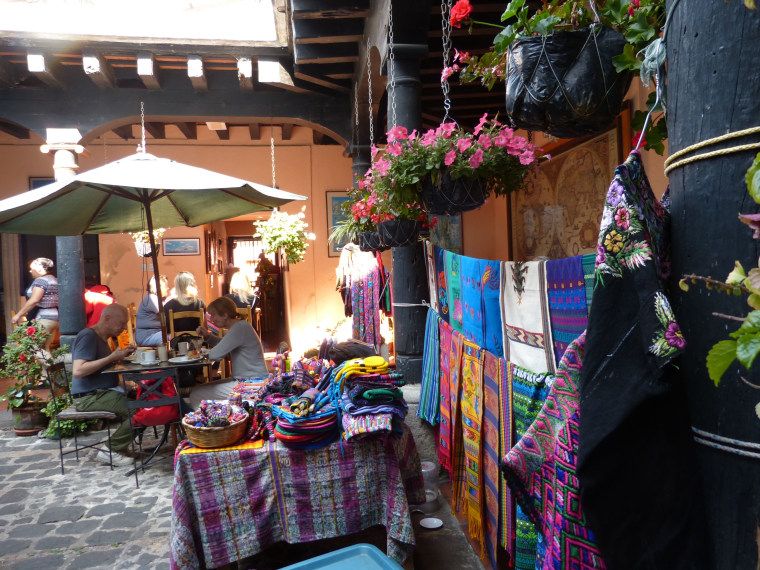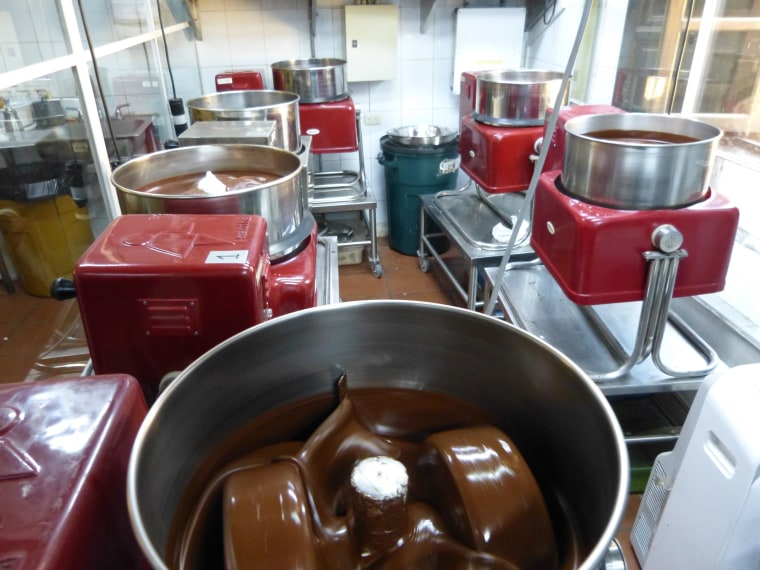ANTIGUA, Guatemala -- The smell of chocolate permeates the long narrow alleys and cobblestoned streets of Guatemala’s ancient colonial capital.
It wafts out behind the colored stucco walls of centuries-old buildings housing establishments with names like Choco Museo, (“the Museum of Chocolate”) and Kaffee Fernando’s, where tourists and locals alike can see the process of chocolate production “from bean to bar,” says Kaffee Fernando’s owner, Fernando Arias, an affable Guatemalan in his 50's and one of the pioneers in Guatemala’s recent chocolate “boom.”
Arias started a chocolate production operation on the premises of his popular café 11 years ago, marketing his quality coffee and chocolate with the slogan: “The best drugs are legal.”

But while the growing number of establishments in Antigua and other Guatemalan cities making artisanal chocolate is a fairly recent phenomenon of the last 10 years or so, the history of chocolate in Guatemala, goes back much further. In fact, Guatemala is often called “the birthplace of chocolate,” where the ancient Mayans considered cacao, the plant and bean from which chocolate is made, a gift from the gods.
Actually, it was the ancient Olmecs of Mexico who first domesticated the variety of cacao know as criollo, and brought it south to the land of the Maya in Guatemala, says Arias. But because the Olmecs did not have a written language, it is the Maya, who documented their refinement of cacao for posterity, who more often get the credit for cacao’s early cultivation.
With the Maya, cacao became an indispensable commodity. As a food and drink — first ground and then mixed with water, honey, corn, and sometimes chile — its consumption in pre-Hispanic times was often reserved for the elites.
“It was also currency,” says Arias, “and when the ancient Mayas and Olmecs, and later, the Aztecs traveled long distances, they took cacao seeds to give them energy … cacao was of paramount importance in MesoAmerican times — you could say it was on top of their agricultural pyramid.”
When the Mayas migrated from the south to the north where Tikal is now, they took two plants with them—the mighty ramon tree, and the cacao plant.

The Aztecs then came into the picture, and when that Mexican civilization conquered the Maya in Guatemala and the Yucatan peninsula, they became great cacao aficionados. The arid growing conditions in Mexico did not lend themselves to growing cacao, so a mighty army guarded the agricultural fields where cacao was grown in the lowlands of Guatemala, and accompanied the harvest north to the Aztec capital of Tenochtitlan at the present site of Mexico City. It is said that the Aztec emperor Moctezuma drank enormous amounts of cacao, especially for its reputation as an aphrodisiac.
With the Spanish conquest, cacao and chocolate traveled across the Atlantic, where at first the rare commodity was reserved for the Spanish nobility. In the meantime, cacao production collapsed in Guatemala, as Spain expanded its geographic reach to South America and saw it could import the beans more easily from Venezuela, on the Atlantic coast. In Guatemala, land that once grew cacao was used for the then flourishing cochineal dye trade, and today, for sugarcane and palm oil cultivation.
“In a way it is ironic that a country with such a long heritage (of chocolate) is just now starting to wake up to the great amount of possibilities for making different products from the locally available cacao,” says Carlos Eichenberger, 53, owner and chocolate maker at Danta Chocolate in Guatemala City.
Eight years ago, Eichenberger gave up a full-time career in the tech industry to follow his bliss to bring world-class chocolate to Guatemala — traveling to France and Italy to learn from master chocolate makers. Now, his upscale boutique chocolate shop in the capital — named after a pyramid in the Mayan site El Mirador, an important center of chocolate consumption in the ancient world — produces 100 pounds of chocolate daily.
Still, he thinks it will be an uphill battle for Guatemala to again become a principal producer of high quality cacao: “You have to remember,” he says, “that there's huge competition for land here in Guatemala, land that is that is already occupied by other crops…”
Back at his café and chocolate factory in Antigua, Arias becomes emotional as he points out that the sugarcane and the palm oil that now occupy much of the country’s agricultural land also erode the soil, and that cacao and chocolate could eventually be much more profitable, and eco-friendly.
“Cacao is the solution because at the same time it's going to better the land and stop erosion and deforestation,” he maintains. “Cacao is the right answer for the lowlands just as coffee is the right answer for the highlands.”
Arias is also convinced that if the land now devoted to sugarcane would instead be designated for cacao, the profits would eventually multiply, making the ancient crop Guatemala’s economic savior. “I really hope that the farmers are putting a great deal of effort into this new wave of cacao and that they succeed because I think it's really our last hope to stop the destruction of our land.”

While a bit more skeptical about the cultural and economic changes needed to make cacao and chocolate important products for Guatemala again, Eichenberger says its not impossible:
“If people started getting enthusiastic about it and people realized that although it takes a lot of work to get going, it's not by any means impossible … It's a lot of hard work, but it's extremely rewarding and it's something that is good for the country and taking it back to its roots.”
